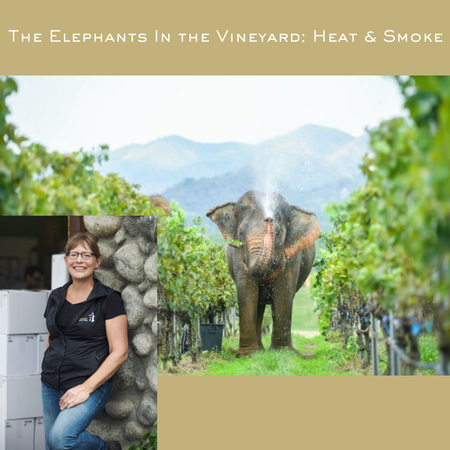Smoke and heat. Everyone wants to know how/if/how badly/how long they may affect the grapes and wine. The answer? So do we! Heat domes and wildfires in grape growing areas are new enough phenomena that we are learning so much year by year.
The good news for us on the Naramata Bench is that we know that fires have to be quite close to affect the wine, and so far this year that has not been the case. Also, most Naramata Bench vineyards are not planted in interface areas, which tend to be higher up and less suitable for ripening.
Hotter and dryer areas such as Napa, Southern California have been doing smoke-related research since the late 90’s, but what we discovered during the Okanagan Mountain Park fire in 2003 was that this research did not necessarily apply to “our” fires, as the fuel burning to create the smoke is quite different.
In 2003 I worked for a large winery which sourced fruit from the length of the valley. We unfortunately had wines that were impacted by two fires that year, the fire in the park as well as an earlier fire on Anarchist Mountain near Osoyoos. The taint from this fire took us by surprise, as the fire quickly burned away from the area and the smoke did not linger so exposure to the vines seemed brief. A few days into the ferment, on skins as they were all red varieties, we started to detect an unmistakable “campfire” smell.
We realized that the brief, early morning blanketing of smoke had made its way into the grape. We now understand that the timing of this fire was the worst possible, just at the onset of veraison – the time when the berries change colour and the skin starts to soften.
Once the fermentation was finished, we had our first taste of the impact smoke can have. The wines had a smoke taste, but also a most unpleasant after-taste…more like licking a dirty ashtray than enjoying bacon around a campfire.
Working with researchers from Napa and the Australian Wine Research Institute, we treated these wines using reverse osmosis filtration and were able to reduce the taint enough that they were drinkable, though very poor examples of what they would have been without the smoke.
One of the most difficult issues in dealing with smoke taint arises from the biology of the vine itself. When presented with a “toxin” the vine attaches the offending molecule to a sugar molecule, essentially deactivating it.
This means that neither the grape or the juice has the smoke taste, but once the sugar is fermented to alcohol, the smoke molecules are released into the wine and their flavour comes out. Until recently, the only way to know whether, and how badly, your vineyard is affected is to pick the fruit and make the wine.
In 2006 researchers at UBC Okanagan, using frozen berries from the 2003 fire season, began work investigating our local fires and the types of chemicals present in grapes that have been exposed to “close-smoke”. They identified a few “marker” compounds that can be analyzed to help predict whether a wine will show taint.
Dr. Wes Zandburg at UBCO has since taken up this work and has set up a series of experiments where he creates smoke tents in vineyards, supplies the fuel that actually burns in our fires (bark, needles, forest floor) and measures the compounds absorbed by the fruit. Vineyards up and down the valley have been sampling for him for the last three years to establish base-line levels of the marker compounds.
His group have developed a test for grapes that predicts subsequent flavour impact in wine, and they are testing out various treatments in the vineyards that might block absorption of taint compounds. This is homegrown research that we can be really proud of.
A beneficial side-effect of smoke is the shading it provides during super-hot periods. Grapevines thrive in temperatures between 20º and low 30’s Celsius, the hotter the better—up to a point. At about 35ºC vines will stop photosynthesizing to focus on temperature regulation, so ripening stalls. We have never had such intense heat in June as we have had this year (maximum 44º C on June 30th), so we don’t really know the long-term effects. I believe it slowed things down just a bit to bring us to an average ripening time-frame.
There is a balance in ripening that we like to see—just the right amount of sugar to give us 12% to 13.5% alcohol, and a good development of aromatics and flavour while retaining a nice acidity. Sometimes late season heat will “bake” the flavour out of fruit as well as drop acidity. The wildfire smoke has prevented this from happening in recent vintages (I know, I know—careful what you wish for!).
BC is a wine region unlike any other. For decades lumped in with other “cool-climate” regions, it was only in the 1990’s that red vinifera vines were considered viable and planted. While we have mid-summer heat similar to Napa, because of our winters we are at the edge of viability for these varieties and have to adapt our growing practices to ensure winter hardiness as well as full-ripening. This puts us on the cutting edge of viticulture research and any climate “anomaly” sends us on a new journey of discovery. It is what makes being a winemaker here so damn interesting.

